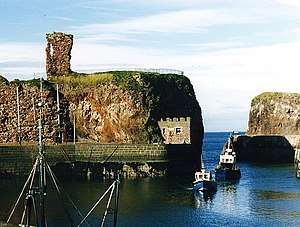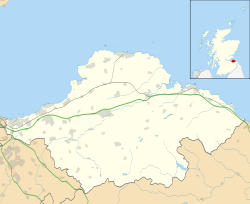Dunbar Castle
| Dunbar Castle | |
|---|---|
| Dunbar, East Lothian, Scotland | |

Dunbar harbour and castle ruins
|
|
| Coordinates | 56°00′20″N 2°31′03″W / 56.0056°N 2.5176°WCoordinates: 56°00′20″N 2°31′03″W / 56.0056°N 2.5176°W |
| Grid reference | grid reference NT67827930 |
| Type | Castle of enceinte |
| Site information | |
| Open to the public |
No |
| Condition | Ruined |
| Site history | |
| Built | first stone castle c.1070 |
| Built by | Gospatric, Earl of Northumbria |
| In use | Until 1567 |
Dunbar Castle is the remnants of one of the strongest fortresses in Scotland, situated in a prominent position overlooking the harbour of the town of Dunbar, in East Lothian.
The Votadini or Gododdin, are thought to have been the first to defend this site, the Brythonic name Dyn Barr, (the fort of the point) is still in use. By the 7th century, Dunbar Castle was a central defensive position of the Kings of Bernicia, an Anglian kingdom that took over from the British Kingdom of Bryneich.
During the Early Middle Ages, Dunbar Castle was held by an Ealdorman owing homage to either the Kings at Bamburgh Castle, or latterly the Kings of York. In 678 Saint Wilfrid was imprisoned at Dunbar, following his expulsion from his see of York by Ecgfrith of Northumbria.
Later, Dunbar was said to have been burnt by Kenneth MacAlpin, King of the Scots. Certainly he is on record in possession of the castle.
In the 10th and early 11th century, the Norsemen made increasing inroads in Scotland and in 1005 a record exists of a Patrick de Dunbar, under Malcolm II, engaged against the Norse invaders in the north at Murthlake a town of Marr where alongside Kenneth, Thane of the Isles, and Grim, Thane of Strathearn, he was slain.
The first stone castle is thought to have been built by Gospatric, Earl of Northumbria, after his exile from England, following the Harrowing of the North, by William the Conqueror after Gospatric took refuge at the court of Malcolm III of Scotland. Gospatric was a powerful landowner in both kingdoms and could summon many men, which encouraged Malcolm to give him more lands in the Merse and Lauderdale, as recompense for those lost further south and in return for loyalty as is usual under the feudal system. Sir Walter Scott argued that Cospatric or Gospatrick was a contraction of Comes Patricius. In any case, King Malcolm III is recorded as bestowing the manor of Dunbar &c., on "the expatriated Earl of Northumberland".
...
Wikipedia

